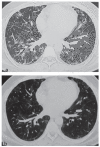Combined pirfenidone, azithromycin and prednisolone in post-H1N1 ARDS pulmonary fibrosis
- PMID: 32476885
- PMCID: PMC7170064
- DOI: 10.36141/svdld.v35i1.6393
Combined pirfenidone, azithromycin and prednisolone in post-H1N1 ARDS pulmonary fibrosis
Abstract
There are no specific data on the management of pulmonary fibrosis post-H1N1 ARDS. We present the cases of three patients who responded positively to treatment with pirfenidone, azithromycin and prednisolone. Three males, aged 40, 45 and 59 years, had H1N1 ARDS requiring mechanical ventilation for two weeks or longer. After weaning off ventilation, they had persistent symptoms and hypoxemia at rest despite receiving prednisolone and home oxygen for at least three weeks following discharge. Computed tomography (CT) of the chest showed fibrosis and traction bronchiectasis. At presentation, they could not perform spirometry. Investigations ruled out infection. Pirfenidone (600 mg daily escalated to maximum tolerable dose of 2.4 gm daily) and azithromycin (500 mg thrice weekly) were added off-label to prednisolone. In one patient pirfenidone was discontinued after three months due to an adverse reaction and azithromycin was continued for nine months. At one year follow-up, all patients had symptomatic improvement, better effort tolerance, regression of opacities and no progression of fibrosis on CT, and improvement in spirometry and six minute walk tests. Pirfenidone and azithromycin added to prednisolone may have led to clinical and radiological improvement. The current experience suggests that this treatment approach to pulmonary fibrosis post-H1N1 ARDS be studied further. (Sarcoidosis Vasc Diffuse Lung Dis 2018; 35: 85-90).
Keywords: ARDS; H1N1; azithromycin; pirfenidone; prednisolone; pulmonary fibrosis.
Copyright: © 2018.
Figures



Similar articles
-
[Standard technical specifications for methacholine chloride (Methacholine) bronchial challenge test (2023)].Zhonghua Jie He He Hu Xi Za Zhi. 2024 Feb 12;47(2):101-119. doi: 10.3760/cma.j.cn112147-20231019-00247. Zhonghua Jie He He Hu Xi Za Zhi. 2024. PMID: 38309959 Chinese.
-
[Chinese experts consensus statement: diagnosis and treatment of cystic fibrosis (2023)].Zhonghua Jie He He Hu Xi Za Zhi. 2023 Apr 12;46(4):352-372. doi: 10.3760/cma.j.cn112147-20221214-00971. Zhonghua Jie He He Hu Xi Za Zhi. 2023. PMID: 36990700 Chinese.
-
Six-Month Outcomes of Post-ARDS Pulmonary Fibrosis in Patients With H1N1 Pneumonia.Front Mol Biosci. 2021 Jun 8;8:640763. doi: 10.3389/fmolb.2021.640763. eCollection 2021. Front Mol Biosci. 2021. PMID: 34169092 Free PMC article.
-
The efficacy and safety of pirfenidone in the treatment of HPS-related pulmonary fibrosis and Idiopathic pulmonary fibrosis: a systematic review and meta-analysis.Eur Rev Med Pharmacol Sci. 2022 Nov;26(22):8411-8424. doi: 10.26355/eurrev_202211_30377. Eur Rev Med Pharmacol Sci. 2022. PMID: 36459024
-
Pirfenidone. First, do no harm.Prescrire Int. 2013 May;22(138):117-9. Prescrire Int. 2013. PMID: 23819168 Review.
Cited by
-
Beneficial effect of sequential treatment with high-dose steroids and short-course oral glucocorticoids in patients with severe influenza virus-associated pneumonia.Sci Rep. 2024 Oct 23;14(1):25023. doi: 10.1038/s41598-024-76400-2. Sci Rep. 2024. PMID: 39443650 Free PMC article.
-
Influenza, SARS-CoV-2, and Their Impact on Chronic Lung Diseases and Fibrosis: Exploring Therapeutic Options.Am J Pathol. 2024 Oct;194(10):1807-1822. doi: 10.1016/j.ajpath.2024.06.004. Epub 2024 Jul 18. Am J Pathol. 2024. PMID: 39032604 Review.
-
Surviving COVID-19: A Burden Yet to Come?Chest. 2021 Jul;160(1):15-16. doi: 10.1016/j.chest.2021.04.019. Chest. 2021. PMID: 34246363 Free PMC article. No abstract available.
-
Factors Affecting Best-Tolerated Dose of Pirfenidone in Patients with Fibrosing Interstitial Lung Disease.J Clin Med. 2023 Oct 13;12(20):6513. doi: 10.3390/jcm12206513. J Clin Med. 2023. PMID: 37892651 Free PMC article.
-
Pulmonary Pathology of End-Stage COVID-19 Disease in Explanted Lungs and Outcomes After Lung Transplantation.Am J Clin Pathol. 2022 Jun 7;157(6):908-926. doi: 10.1093/ajcp/aqab208. Am J Clin Pathol. 2022. PMID: 34999755 Free PMC article.
References
-
- American Thoracic Society (ATS), European Respiratory Society (ERS) Idiopathic pulmonary fibrosis: diagnosis and treatment. Am J Respir Crit Care Med. 2000;161:646–64. - PubMed
-
- Biffl WL, Moore FA, Moore EE, Haenel JB, McIntyre RC, Jr, Burch JM. Are corticosteroids salvage therapy for refractory acute respiratory distress syndrome. Am J Surg. 1995;170:591–6. - PubMed
Publication types
LinkOut - more resources
Full Text Sources
Other Literature Sources
Medical
